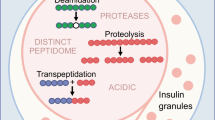Abstract
PROTEASOMES are highly conserved macromolecular structures which function as endopeptidases1–3. They are found in the cyto-plasm and nucleus of eukaryotic tissues and consist of at least 14 non-identical subunits with molecular masses ranging from ∼20 to 32K. Proteasomes are essential in the selective degradation of ubiquitinated and certain non-ubiquitinated proteins, acting as the proteolytic core of an energy-dependent 26S (1,500K) proteolytic complex. Two proteasome subunits, LMP2 and LMP7 (refs 4–7), are encoded within the major histocompatibility complex (MHC), implicating proteasomes in antigen processing8,9. Here we deter-mine the function of these two MHC-linked subunits by comparing the proteolytic activities of purified proteasomes containing (LMP+) or lacking (LMP−) these components. We find that pro-teasomes of both types have endopeptidase activity against sub-strates bearing hydrophobic, basic or acidic residues immediately preceding the cleavage site (the PI position) and at sites following asparagine, glycine and proline residues. The activity of LMP+ proteasomes is much higher than that of LMP− proteasomes against substrates with hydrophobic, basic or asparagine residues at PI, whereas their activities are comparable when acidic and glycine residues are present at PI. The MHC-linked LMP2 and LMP7 subunits therefore function to amplify specific endopeptid-ase activities of the proteasome.
Similar content being viewed by others
References
Goldberg, A. L. Eur. J. Biochem. 203, 9–23 (1992).
Orlowski, M. Biochemistry 29, 10289–10297 (1990).
Rivett, A. J. Archs Biochem. Biophys. 268, 1–8 (1989).
Brown, M. G., Driscoll, J. & Monaco, J. J. Nature 353, 355–357 (1991).
Ortiz-Navarrete, V. et al. Nature 353, 662–664 (1991).
Glynne, R. et al. Nature 353, 357–360 (1991).
Martinez, C. K. & Monaco, J. J. Nature 353, 664–667 (1991).
Monaco, J. J. Immun. Today 13, 173–179 (1992).
Michalek, M. T., Grant, E. P., Gramm, C., Goldberg, A. L. & Rock, K. L. Nature 363, 552–554 (1993).
Arnold, D. et al. Nature 360, 171–174 (1992).
DeMars, R. et al. Proc. natn. Acad. Sci. U.S.A. 82, 8183–8187 (1985).
Spies, T. et al. Nature 348, 744–747 (1990).
Brown, M. G., Driscoll, J. & Monaco, J. J. J. Immun. 151, 1193–1204 (1993).
Yang, Y., Waters, J. B., Früh, K. & Peterson, P. A. Proc. natn. Acad. Sci. U.S.A. 89, 4928–4932 (1992).
Rötzschke, O. & Falk, K. Immun. Today 12, 447–455 (1991).
Jardetzky, T. S., Lane, W. S., Robinson, R. A., Madden, D. R. & Wiley, D. C. Nature 353, 326–329 (1991).
Hunt, D. F. et al. Science 255, 1261–1263 (1992).
DiBrino, M. et al. Proc. natn. Acad. Sci. U.S.A. 90, 1508–1512 (1993).
Sutton, J. et al. Eur. J. Immun. 23, 447–453 (1993).
Momburg, F. et al. Nature 380, 174–177 (1992).
Orino, E. et al. FEBS Lett. 284, 206–210 (1991).
Author information
Authors and Affiliations
Rights and permissions
About this article
Cite this article
Driscoll, J., Brown, M., Finley, D. et al. MHC-linked LMP gene products specifically alter peptidase activities of the proteasome. Nature 365, 262–264 (1993). https://doi.org/10.1038/365262a0
Received:
Accepted:
Issue Date:
DOI: https://doi.org/10.1038/365262a0
- Springer Nature Limited
This article is cited by
-
The Role of Immunoproteasomes in Tumor-Immune Cell Interactions in Melanoma and Colon Cancer
Archivum Immunologiae et Therapiae Experimentalis (2022)
-
Antigen presentation in cancer: insights into tumour immunogenicity and immune evasion
Nature Reviews Cancer (2021)
-
Efficiency of the four proteasome subtypes to degrade ubiquitinated or oxidized proteins
Scientific Reports (2020)
-
Endothelial IL-8 induced by porcine circovirus type 2 affects dendritic cell maturation and antigen-presenting function
Virology Journal (2019)
-
The ubiquitin–proteasome system in kidney physiology and disease
Nature Reviews Nephrology (2019)





